Sources
 This article incorporates text from a publication now in the public domain : Shahan, Thomas Joseph (1907). "Auxentius". In Herbermann, Charles (ed.). Catholic Encyclopedia . Vol. 2. New York: Robert Appleton Company.
This article incorporates text from a publication now in the public domain : Shahan, Thomas Joseph (1907). "Auxentius". In Herbermann, Charles (ed.). Catholic Encyclopedia . Vol. 2. New York: Robert Appleton Company.
Auxentius | |
|---|---|
| Other names | Mercurinus |
| Parent | (adopted by) Wulfila |
Offices held | Bishop of Milan |
Auxentius of Durostorum, also probably known as Mercurinus, was a bishop of Durostorum. An Arian, he was prominent in conflict with St Ambrose.
Auxentius was the foster-son of Wulfila, the "apostle to the Goths". He is referred to by St Ambrose as "Mercurinus", but in an extravagant document written at the height of a bitter dispute with the Imperial court, apparently in order to accuse his rival with having changed his name from Mercurinus in order to curry favour with supporters of another Auxentius who had been Ambrose's predecessor; the robustness of this accusation is unknown. [1]
Auxentius was bishop of Durostorum on the lower Danube, but was expelled by an edict of Theodosius depriving Arian bishops in 383, and took refuge at Milan where he became embroiled in controversy with St Ambrose. [1]
In Milan, seat of the Western Imperial court, Nicene and Arian controversy flared high. In 386, Auxentius challenged Ambrose to a public disputation, in which the judges were to be the court favourites of the Arian empress; he also demanded for the Arians the use of the Basilica Portiana. Ambrose's refusal to surrender this church brought about a siege of the edifice, in which Ambrose and a multitude of his faithful Milanese had shut themselves up. The empress eventually abandoned her favourite and made peace with Ambrose. [2]
He wrote an account of the life and death of Ulfilas that the Arian bishop Maximinus included (383) in a work directed against St. Ambrose and the Synod of Aquileia, 381. This favourite of Empress Justina was the anti-bishop set up in Milan by the Arians on the occasion of the election of Ambrose.
The Letter of Auxentius (ca 400) was preserved in the margins of a manuscript of De fide of Ambrose. Along with the Creed of Ulfilas it is one of the chief witnesses to the credence of the Arian Christians and the politics of the Church at the time when Nicene Christianity continued to be debated at the highest levels of the Catholic Church.
Arianism is a Christological doctrine considered heretical by all mainstream branches of Christianity. It is first attributed to Arius, a Christian presbyter who preached and studied in Alexandria, Egypt. Arian theology holds that Jesus Christ is the Son of God, who was begotten by God the Father with the difference that the Son of God did not always exist but was begotten/made before "time" by God the Father; therefore, Jesus was not coeternal with God the Father, but nonetheless Jesus began to exist outside time as time applies only to the creations of God.

Ambrose of Milan, venerated as Saint Ambrose, was a theologian and statesman who served as Bishop of Milan from 374 to 397. He expressed himself prominently as a public figure, fiercely promoting Roman Christianity against Arianism and paganism. He left a substantial collection of writings, of which the best known include the ethical commentary De officiis ministrorum (377–391), and the exegetical Exameron (386–390). His preachings, his actions and his literary works, in addition to his innovative musical hymnography, made him one of the most influential ecclesiastical figures of the 4th century.
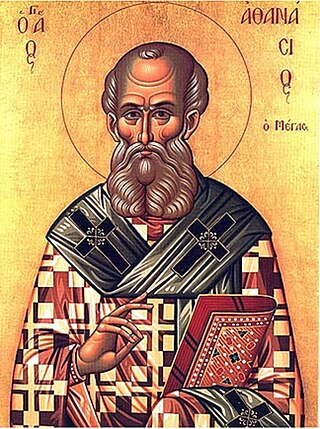
Athanasius I of Alexandria, also called Athanasius the Great, Athanasius the Confessor, or, among Coptic Christians, Athanasius the Apostolic, was a Christian theologian and the 20th pope of Alexandria. His intermittent episcopacy spanned 45 years, of which over 17 encompassed five exiles, when he was replaced on the order of four different Roman emperors. Athanasius was a Church Father, the chief defender of Trinitarianism against Arianism, and a noted Egyptian Christian leader of the fourth century.
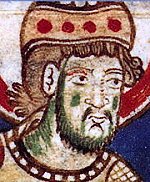
Pope Damasus I, known as Damasus of Rome, was the bishop of Rome from October 366 to his death. He presided over the Council of Rome of 382 that determined the canon or official list of sacred scripture. He spoke out against major heresies, thus solidifying the faith of the Catholic Church, and encouraged production of the Vulgate Bible with his support for Jerome. He helped reconcile the relations between the Church of Rome and the Church of Antioch, and encouraged the veneration of martyrs.
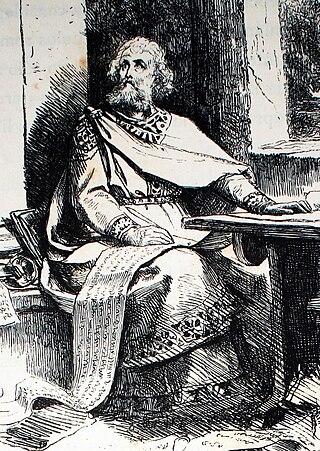
Ulfilas, known also as Wulfilas or Urphilas, was a 4th century Gothic preacher of Cappadocian Greek descent. He was the apostle to the Gothic people and the father of Germanic literature.
The 380s decade ran from January 1, 380, to December 31, 389.
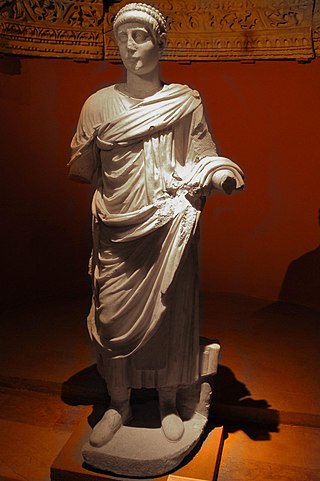
Valentinian II was a Roman emperor in the western part of the Roman empire between AD 375 and 392. He was at first junior co-ruler of his half-brother, was then sidelined by a usurper, and only after 388 sole ruler, albeit with limited de facto powers.

Hilary of Poitiers was Bishop of Poitiers and a Doctor of the Church. He was sometimes referred to as the "Hammer of the Arians" and the "Athanasius of the West". His name comes from the Latin word for happy or cheerful. In addition to his important work as bishop, Hilary was married and the father of Abra of Poitiers, a nun and saint who became known for her charity.
Auxentius: This name derives from the Ancient Greek “aúksēsis (αὔξησις) auksanō (αὐξάνω) auxantios (Αὐξήντιος)”, meaning “increasing, increase, growth”. This name was borne by several early saints as St. Auksencjusz of Bithynia. Auxentius was an Arian theologian and bishop of Milan.

Lucifer of Cagliari was a bishop of Cagliari in Sardinia known for his passionate opposition to Arianism. He is venerated as a Saint in Sardinia, though his status remains controversial.
Justina was a Roman empress. She was initially the wife of the rebel emperor Magnentius and was then married to Valentinian I, with whom she had four children, including the emperor Valentinian II and the empress Galla.
Auxentius of Milan or of Cappadocia, was an Arian theologian and bishop of Milan. Because of his Arian faith, Auxentius is considered by the Catholic Church as an intruder and he is not included in the Catholic lists of the bishops of Milan such as that engraved in the Cathedral of Milan.
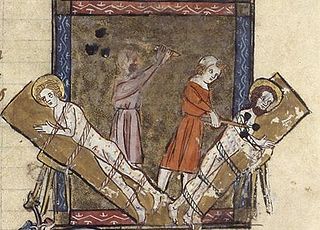
Gervasius and Protasius are venerated as Christian martyrs, probably of the 2nd century. They are the patron saints of Milan and of haymakers and are invoked for the discovery of thieves. Their feast day in the Latin Rite of the Catholic Church is 19 June, the day marking the translation of their relics. In the Eastern Orthodox Church and in the Eastern Rites of the Catholic Church, their feast takes place on 14 October (O.S.)/24 October (N.S.), the traditional day of their death. In Christian iconography their emblems are the scourge, the club and the sword.
Gothic Christianity refers to the Christian religion of the Goths and sometimes the Gepids, Vandals, and Burgundians, who may have used the translation of the Bible into the Gothic language and shared common doctrines and practices.
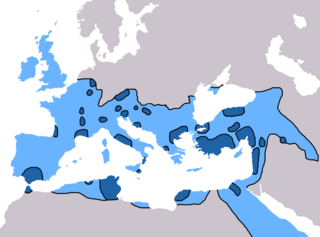
Christianity in the 4th century was dominated in its early stage by Constantine the Great and the First Council of Nicaea of 325, which was the beginning of the period of the First seven Ecumenical Councils (325–787), and in its late stage by the Edict of Thessalonica of 380, which made Nicene Christianity the state church of the Roman Empire.

Christianity in late antiquity traces Christianity during the Christian Roman Empire — the period from the rise of Christianity under Emperor Constantine, until the fall of the Western Roman Empire. The end-date of this period varies because the transition to the sub-Roman period occurred gradually and at different times in different areas. One may generally date late ancient Christianity as lasting to the late 6th century and the re-conquests under Justinian of the Byzantine Empire, though a more traditional end-date is 476, the year in which Odoacer deposed Romulus Augustus, traditionally considered the last western emperor.

Constantine the Great's (272–337) relationship with the four Bishops of Rome during his reign is an important component of the history of the Papacy, and more generally the history of the Catholic Church.


Dionysius was bishop of Milan from 349 to 355. He is honoured as a Saint in the Catholic and Eastern Orthodox Churches and his feast day is 25 May.
Arian creeds are the creeds of Arian Christians, developed mostly in the fourth century when Arianism was one of the main varieties of Christianity.